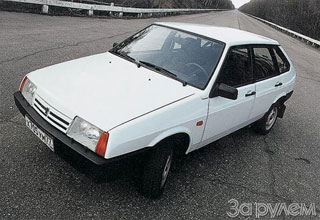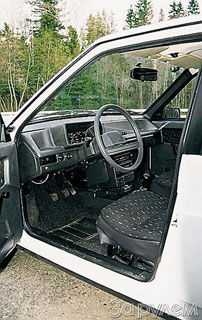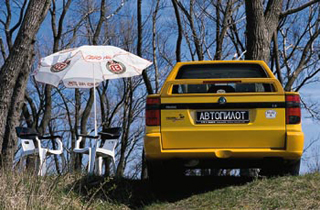Skoda Felicia 1995 test drive - 2001 -
Patriots and cosmopolitans
 Which car to choose? Previously, such a question was deprived of meaning. They took what they could. Now that everything and everything is sold, it is not easy to make a choice.
Which car to choose? Previously, such a question was deprived of meaning. They took what they could. Now that everything and everything is sold, it is not easy to make a choice. Imagine a certain average Russian citizen, who, fortunately, bypassed the problem of unemployment, non -payment of salaries. He has a job for which money is paid, and there is a natural desire to purchase a car. Our imaginary character will work over time (accumulated, inherited, etc.) in the amount of about 10,000. e. Now his capabilities coincide with his desire and it remains only to make a choice.
Today, for such an amount, you can purchase any domestic car, preceded or even a new foreign car. We will not talk about technology that are in use - this is a separate topic. We calculate that our hero wants to purchase only a new car. Then he remains two ways: either to choose something from the domestic, or at the limit of financial capabilities to buy a small, prestigious, but relatively inexpensive car of foreign production.
Further, doubts and attempts to resolve them begin - surveys of relatives, friends, acquaintances, relatives and friends of acquaintances and other experts. The result of an impromptu sociological study will probably only confuse - how many people, so many opinions.
 The best way to get to the bottom of the truth is to put an experiment. We undertook to spend it. And for starters they bought ... two cars - imported and domestic.
The best way to get to the bottom of the truth is to put an experiment. We undertook to spend it. And for starters they bought ... two cars - imported and domestic. It is clear, at the same time I also had to solve the problem of choice. The basic price of each car was to be laid in the amount indicated above. Cars? Of course, one class is easier to conduct comparisons, moreover, more or less we have common, so that there are no problems with maintenance and repair. Through simple conclusions, they came to the conclusion: the classic VAZ will not suit - it will not be easy to find a foreign classmate with rear -wheel drive. The Volga also disappeared - her foreign colleagues are too expensive. For some reason, the Muscovite was not even considered. There were front -wheel drive VAZ models. Of these, the choice fell on the nine. Well, the role of a foreign competitor was taken by the Czech -German Skoda Felicia - our car is already very popular.
So one of the examiners (Yuri Nechetov) became a patriot - he got a domestic car, another (the author of the article) was to get used to the image of a cosmopolitan, who was no longer seduced by the equipment in Russia. Both cars were bought in the salons of official dealers - no re -export and left -wing customs. This is an important part, since the cars are planned to be operated with a civilized way - in the warranty period, all service and repairs (if necessary) are carried out only on the company service.
 What's next? We intend to regularly prepare reports on the life of Skoda and nine, and these publications should differ slightly from the usual operating experience in the heading. Malfunctions, breakdowns (if any) and the methods of eliminating them will be evaluated, first of all, from the point of view of the economy - what it costs the owner. It is interesting in your skin to feel the price of a beautiful automobile life and find out if this life is beautiful. How much trouble will be delivered in comparison with the domestic machine, will there be problems with spare parts, how will you serve at the service station? Will the cheaper VAZ 2109 rival Skoda at a price due to frequent malfunctions and costs of repairs or the high cost of imported details will devastate the pocket of the owner of Felicia at the first breakdown? And, of course, how often these same breakdowns will occur in one and the other machine. In short, which of the contribution cars will require less time, effort and money from the owner. This may be the most important for those who buy a car in order to drive a lot, and not satisfy their amateur ambitions.
What's next? We intend to regularly prepare reports on the life of Skoda and nine, and these publications should differ slightly from the usual operating experience in the heading. Malfunctions, breakdowns (if any) and the methods of eliminating them will be evaluated, first of all, from the point of view of the economy - what it costs the owner. It is interesting in your skin to feel the price of a beautiful automobile life and find out if this life is beautiful. How much trouble will be delivered in comparison with the domestic machine, will there be problems with spare parts, how will you serve at the service station? Will the cheaper VAZ 2109 rival Skoda at a price due to frequent malfunctions and costs of repairs or the high cost of imported details will devastate the pocket of the owner of Felicia at the first breakdown? And, of course, how often these same breakdowns will occur in one and the other machine. In short, which of the contribution cars will require less time, effort and money from the owner. This may be the most important for those who buy a car in order to drive a lot, and not satisfy their amateur ambitions. We will also not forget about those who can and love to hold the wrench in their hands - we will evaluate the complexity of service and minor repairs. Naturally, in comparison. If in our Felicia in the post-warranty period something will break or fall apart, it is waiting for the technical center at the wheel and the heading on its own. And in the nine, not everything has been dismantled yet. You can talk about additional equipment, accessories, non -native spare parts ... The plans are large, we will engage in their implementation. Who is interested - read.
The fact that we chose precisely VAZ 21093 and Skoda does not mean that we did not think about other cars. It could be a dozen and Nexia, Tavria and Fiat Uno. Nevertheless, we stopped at the most common ones, allowing us to feel the difference to a greater extent. We believe that the couple we have chosen makes it possible to do this.
 Now it's time to present the test participants.
Now it's time to present the test participants. In the blue corner - VAZ 21093, basic equipment (panel and that low), color - white, price - 42 551 rubles. In the red corner - Skoda Felicia 1.3LX, basic equipment, color - cherry metallic, price - 59,963 rubles.
Both cars were not without flaws. Skoda did not want to discard idling below one and a half thousand. This defect was easily eliminated. The reason was the jamming of the shift drive.
Nine suffered a whole bunch of diseases: failure to accelerate, a roar of upholstery, screech of brake pads, dead hydraulic corrector of headlights, short -leafing antifreeze, unstressed wheels, jamming the castle of the fifth door. There will be something to do during the first visit to the service station, which, according to the instructions, should take place between two and three thousand kilometers.
Czech, as already mentioned, is more expensive than Russians for more than 17 thousand rubles. Why had to pay a lot of money? For an attractive appearance, high -quality painting (although the final verdict here will take time and rust), thorough assembly, a cozy salon. Its decoration seems simply chic against the background of nine. The latter is depressed with rude plastic, crooked panels and an abundance of burrs on them, which strive to scratch their fingers.
But the characteristics of the Skodovsky engine look more than modest, despite the fact that according to the factory data, the car is not at all a slow -moving. The perfectly horizontal landfill and accurate measuring equipment allowed us to check some statements of manufacturers. The measurement results are given in the table. Comparing them with the data from the official technical characteristics, let's see which of the firms - the Russian or Czech was closer to the truth.
 So, let's turn to the table. The real maximum speed of Samara is more than 11 km/h lower than the declared. Skoda actually showed 147.2 km/h - better than 2.7 km/h than promised.
So, let's turn to the table. The real maximum speed of Samara is more than 11 km/h lower than the declared. Skoda actually showed 147.2 km/h - better than 2.7 km/h than promised. Acceleration from a place to one hundred kilometers per hour: Felicia showed 16.85 s at 15 announced, Samara - 14.97 at 13 on a passport. Both cars were a little slower than it was stated.
Fuel consumption: at a speed of 90 km/h, the received numbers almost accurately coincided with the official, but with 120 km/h the appetite of the engines turned out to be slightly higher than the promised.
By elasticity, Skoda was ahead of what we, frankly, expected. Its engine is an outright traction, especially in comparison with the Samara motor, which wakes up at higher speeds.
The braking distance of Skoda is noticeably longer than the nine, but the effort on the pedals of the brake has less. This creates the driver's feeling that the brakes of Felicia are more effective. In addition, Samara demonstrated one of her worst qualities: after a series of races, her brakes overheated and the braking distance began to grow. (But this is the topic of individual material in one of the closest numbers of the magazine.) Samara is worse. She ran away from her significantly less than at Skoda.
What did you get in the end? The results of measurements confirmed our subjective sensations. The only thing that can be noted is a solid shortage of nine maximum speed. There are presumably two reasons: the engine does not give out the laid characteristics or the factory figure is overstated. Of course, to say that one car is better and the other is worse, early. So far, we will only note what we know well: the trouble of Russian technology is its low quality, moreover, also unstable. However, we got a successful Samara and, although there are enough minor defects, until nothing serious was revealed. For a hand, to cope with the little things - a couple of trifles. We will not fundamentally do this, we will go to the guarantee to achieve what we are supposed to - to eliminate defects. We will talk about the results of visiting branded technical centers next time. Then we will make the first economic estimates.
 The first impressions
The first impressions The opinion of the patriot. Paying extra money for the appearance and interior is stupidity. I will bring Samara to mind myself. Hands for what?! But without problems you can repair anywhere and on the way to the country you will not have to cling to every bump with a belly.
The opinion of the cosmopolitan. Tired of working as a car mechanic part -time, feel like a tractor driver and enjoy the roar of upholstery panels. I would like to feel like a man, the owner of the car, and not her slave. Talking for cross -country ability is groundless. If you really want to cross dirt - the best option is still not Samara, but a field or something more abrupt if there is enough money.
Pay attention to the road clearance - not to argue with Samara in the cross -country ability.
The interior of Skoda is far from the last word of design, but even in comparison with it, Devyatkin's salon looks wretched.
The trunk of Felicia is smaller than the nine, but its opening is more convenient - the door reaches the bumper.
TECHNICAL SPECIFICATIONS
General data: number of places - 5; equipped mass - 920 kg; full weight - 1345 kg; maximum speed - 156 km/h; acceleration time from a place to 100 km/h - 13 s; fuel consumption at 90, 120 km/h and Hz - 5.7; 7.7; 8.7 l/100 km; fuel supply - 43 liters; Fuel - AI -91. Dimensions, mm: length - 4006; width - 1650; height - 1402; base - 2460; The track in front/back - 1400/1370; Road clearance - 160; trunk volume - 330 l; The radius of rotation is 5.2 m. Engine: in line four -cylinder carburetor, two valves per cylinder; working volume - 1500 cm; cylinder diameter and piston stroke - 82x71 mm; compression degree - 9.9; Power - 52.6 kW/71.5 liters. With. at 5600 rpm; The maximum torque is 106.4 N.M at 3400 rpm. Transmission: front wheel drive; gearbox - five -speed mechanical; Transporting numbers: I - 3.636; II - 1.95; III - 1.357; IV - 0.941; V - 0.784; h. X. - 3.53; The main program is 3.94. Suspension: front - McEferson, the rear - on longitudinal levers connected by a transverse beam. Brakes: with an amplifier, front - disk, rear - drum. Steering: rheck. Tire size: 165/70 R13.
TECHNICAL SPECIFICATIONS
General data: number of places - 5; Equipped mass - 935 kg; full weight - 1420 kg; maximum speed - 145 km/h; acceleration time from a place to 100 km/h - 15 s; fuel consumption at 90, 120 and Hz - 5.7; 7.9; 9.0 l/100 km; fuel supply - 47 l; Fuel - AI -91. Dimensions, mm: length - 3855; width - 1635; height - 1415; base - 2450; The track in front/back - 1420/1380; road clearance at full load - 110 mm; trunk volume - 272 l; The turning radius is 5.6 m. Engine: in a four -cylinder carburetor, two valves per cylinder; working volume - 1289 cm; cylinder diameter and piston stroke - 75.5x72 mm; compression degree - 8.8; Power - 43 kW/58 liters. With. at 5000 rpm; The maximum torque is 94 N.M at 3000 rpm. Transmission: front wheel drive; gearbox - five -speed mechanical; Transporting numbers: I - 3.308; II - 1.913; III - 1.267; IV - 0.927; V - 0.717; h. X. - 2.923; The main program is 4,118. Suspension: front - McEferson, the rear - on longitudinal levers connected by a transverse beam. Brakes: with an amplifier, front - disk, rear - drum. Steering: rheck. Tire size: 165/70 R13.
Igor Solidov. Photo by the author






Source: The magazine "Driving"








